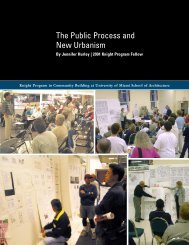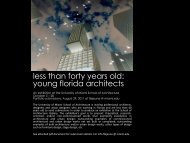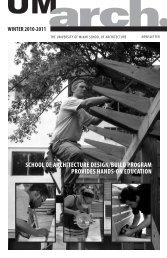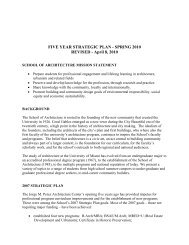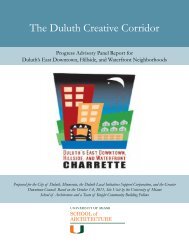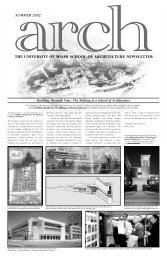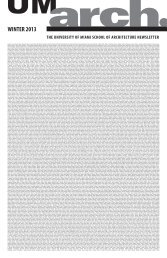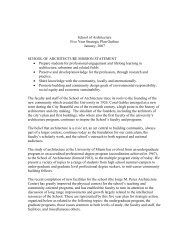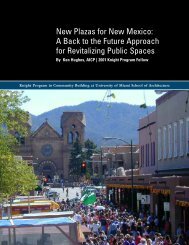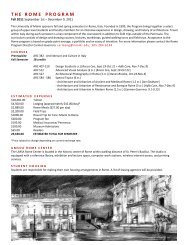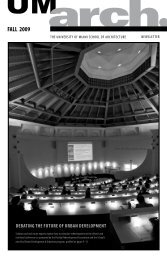Emerging Green Builders Symposium - University of Miami School ...
Emerging Green Builders Symposium - University of Miami School ...
Emerging Green Builders Symposium - University of Miami School ...
Create successful ePaper yourself
Turn your PDF publications into a flip-book with our unique Google optimized e-Paper software.
<strong>Emerging</strong> <strong>Green</strong> <strong>Builders</strong> <strong>Symposium</strong><br />
“Tropical Vernacular Architecture”<br />
at the <strong>University</strong> <strong>of</strong> <strong>Miami</strong> <strong>School</strong> <strong>of</strong> Architecture<br />
Jorge M. Perez Architecture Center<br />
1215 Dickinson Drive<br />
Coral Gables Campus<br />
Saturday, March 7, 2009<br />
We will provide 4 Sustainable Design CEU’s at this Conference.<br />
Please register at http://arc.miami.edu/tropical-vernacular-symposium<br />
Direct and questions to Brian Lemmerman:<br />
954-304-2468 or email brian_lemmerman@yahoo.com<br />
General Purpose<br />
To educate EGB members, the UM student body, the general public, and pr<strong>of</strong>essionals about the<br />
importance <strong>of</strong> learning from the past to build a sustainable future in tropical climates. Lectures will<br />
provide insight on vernacular building types and techniques through the unique perspectives <strong>of</strong> each <strong>of</strong><br />
our speakers at they discuss projects they’ve studied and built in different parts <strong>of</strong> the tropical belt. The<br />
public will learn that green buildings don’t require space-age technologies to function. Students and<br />
pr<strong>of</strong>essionals will better understand how buildings relate to their surroundings so they can apply those<br />
principles to their own practices.<br />
Tentative Schedule<br />
11:00am-12:00pm: Registration + Lunch-catered by <strong>Green</strong> Gables Café, Whisk, and Eurotable<br />
12:00pm-12:10pm: Welcome by Liz Plater-Zyberk and Introduction by Brian Lemmerman<br />
12:10pm-1:05pm: Speaker 1- Maria Veronica Machado. Adib Cure to translate.<br />
1:05pm-2:00pm: Speaker 2- Thorn Grafton<br />
2:00pm-2:25pm: Speaker 3- Mark Schrieber<br />
2:25 pm-2:35pm: Sierra Club- Urban Development Boundary Issues in Parkland<br />
2:35pm-3:00pm: Snack/Restroom Break-catered by LA Sweets and Whole Foods<br />
3:00pm-3:55pm: Speaker 4- Nnamdi Elleh<br />
3:55pm-4:30pm: Speaker 5- Ricardo Lopez, Jose Venagas, Steven Fett, and Graham Ivory<br />
4:35pm-5:30pm: Speaker 6- Steve Mouzon<br />
5:30pm-5:50pm: Question and Answer Session. Mason McPhee as Moderator<br />
5:50pm-6pm: Closing Remarks
Speaker: Maria Veronica Machado- 50 minutes<br />
Biography<br />
Graduated Summa Cum Laude and current pr<strong>of</strong>essor and researcher at the <strong>University</strong> <strong>of</strong> Zulia,<br />
<strong>School</strong> <strong>of</strong> Architecture in 1996. She has a Masters <strong>of</strong> Advanced Technologies in Architectural<br />
Construction at the Polytechnic <strong>University</strong> <strong>of</strong> Madrid in 1998. She has written over 70 papers for<br />
national and international scientific organizations including PLEA- Passive and Low Energy<br />
Architecture, ISES- International Solar Energy Society, and COTEDI- Congreso Latinoamericano Sobre<br />
Confort y Comportamiento Termico de las Edificiones. She has also produced 18 research papers for<br />
several internationally recognized architectural journals.<br />
Lecture<br />
The Impact <strong>of</strong> Maracaibo’s Humid Subtropical Climate on its Architecture; Past and Present.<br />
An overview <strong>of</strong> the planet’s climatic and environmental conditions around the tropical belt and<br />
their effects on the evolution <strong>of</strong> vernacular buildings in those regions to raise the awareness <strong>of</strong> architects<br />
about proper building siting and environmental sensitivity. A focus on the subtropical zone and<br />
specifically on Maracaibo Lake shows us how the hot and humid climate has a direct impact on how<br />
buildings have responded to its climate through history, and how recent housing proposals arising from<br />
the research <strong>of</strong> the Lab-ller_VA (Laboratory and Workshop in Video Architecture) at the <strong>University</strong> <strong>of</strong><br />
Zulia.
Speaker: Thorn Grafton- 50 minutes<br />
Biography<br />
<strong>Miami</strong> Architect Thorn Grafton was principal in his own practice for 25 years before joining<br />
Zyscovich Architects in 2005. As the firm’s Director <strong>of</strong> Sustainable Initiatives - Grafton coordinates<br />
projects in the LEED pipeline (approximately 15 in 2009), including projects for higher education, K-12<br />
schools, corporate, municipal, historic and existing buildings. Grafton was an early leader in promoting<br />
the sustainable design movement locally, advocating that “green” architecture address the region’s hot<br />
and humid climate. He was a founding member <strong>of</strong> the local USGBC chapter, and he continues to make<br />
presentations on environmental and green design topics to pr<strong>of</strong>essional and community groups. Grafton<br />
holds a Master <strong>of</strong> Architecture from Tulane <strong>University</strong>, and has been a part-time instructor at the<br />
<strong>University</strong> <strong>of</strong> <strong>Miami</strong> <strong>School</strong> <strong>of</strong> Architecture.<br />
Lecture<br />
Design Inspiration from Hot & Humid Zones<br />
A visual survey <strong>of</strong> the best <strong>of</strong> South Florida Architecture leaves unanswered questions – why is<br />
there not more <strong>of</strong> the good stuff The Florida Vernacular, Sub-Tropical Modernism, The Sarasota<br />
<strong>School</strong> – continue to make valuable contributions to our built legacy, yet the bulk <strong>of</strong> our horizontal and<br />
then vertical expansion lacks evidence <strong>of</strong> this. Step 1: Understand the essence <strong>of</strong> these movements; Step<br />
2: Review exquisite design overtures from other H&H zones around the world; Step 3: In the face <strong>of</strong> a<br />
changing South Florida environment in the decades to come, can architecture be <strong>of</strong> the environment<br />
(regenerative), instead <strong>of</strong> just an imposition in it
Speaker: Mark Schrieber – 20 Minutes<br />
Biography<br />
An Intern Architect at Max Strang Architecture where the firm's environmental sensibilities and<br />
design aesthetics continue to attract a diverse array <strong>of</strong> residential and commercial clientele. Currently<br />
Mark is working on several exciting local and international projects which will be striving for LEED<br />
Certification. Mark is a graduate <strong>of</strong> the <strong>University</strong> <strong>of</strong> <strong>Miami</strong> <strong>School</strong> <strong>of</strong> Architecture, where he was<br />
awarded the Alpha Rho Chi Bronze Medal. He is a LEED Accredited Pr<strong>of</strong>essional and serves on the<br />
USGBC <strong>Emerging</strong> <strong>Green</strong> <strong>Builders</strong> National Committee. In the past Mark has worked with the City <strong>of</strong><br />
<strong>Miami</strong> Office <strong>of</strong> Sustainable Initiatives and currently consults the City <strong>of</strong> Lauderhill on their<br />
sustainability efforts.<br />
Lecture<br />
An introduction to natural building processes and sustainable living in the tropics. Learning by<br />
experience living at Rancho Mastatal in the foothills <strong>of</strong> La Cangreja National Park, Costa Rica, where<br />
typical construction techniques include bamboo and timber frame structures, wattle and daub walls, cob<br />
floors and natural plaster. Mark will tell his story <strong>of</strong> his experience abroad.
Speaker: Nnamdi Elleh- 50 minutes<br />
Biography<br />
Associate Pr<strong>of</strong>essor <strong>of</strong> architecture history and theory at the College <strong>of</strong> Design, Architecture,<br />
Art, and Planning (DAAP), <strong>University</strong> <strong>of</strong> Cincinnati. He was trained as an architect at the <strong>University</strong> <strong>of</strong><br />
Wisconsin-Milwaukee and he received his Ph.D. in art history from Northwestern <strong>University</strong>. He is the<br />
recipient <strong>of</strong> many awards, including Samuel Kress and Graham Architectural Foundation grants. He was<br />
the Samuel Ittleson Pre-Doctoral Fellow (2000-2002) at the Center for Advanced Study in the Visual<br />
Arts, National Gallery <strong>of</strong> Art (CASVA), Washington, D.C.; the recipient <strong>of</strong> the outstanding junior<br />
faculty award at the <strong>University</strong> <strong>of</strong> Cincinnati in 2003, and he was named a Distinguished Visiting<br />
Architectural Historian at the <strong>School</strong> <strong>of</strong> Architecture, <strong>University</strong> <strong>of</strong> Cape Town, South Africa, in 2007.<br />
His books include African Architecture, Evolution and Transformation, the first comprehensive text on<br />
African architecture from antiquity to the present; Architecture and Power in Africa, and Abuja: The<br />
Single Most Ambitious Urban Design Project <strong>of</strong> the 20 th Century. Elleh has contributed to several<br />
national and international exhibitions, served on the board <strong>of</strong> directors <strong>of</strong> DOCUMOMO, US, and is also<br />
a current member <strong>of</strong> the board <strong>of</strong> Directors <strong>of</strong> the Society <strong>of</strong> Architectural Historian.<br />
Lecture<br />
<strong>Builders</strong> <strong>of</strong> Poor African Neighborhoods as Environmentally Conscious Modernists and Contemporary<br />
Designers.<br />
Do the houses in the economically and politically underprivileged neighborhoods and districts <strong>of</strong><br />
great African cities such as Port Elizabeth, Khartoum, Dar es Salaam, Fez, Durban, Johannesburg,<br />
Kinshasa, Lagos and Nairobi belong in the discourse <strong>of</strong> sustainable modern and contemporary<br />
architectural practices<br />
How can we overlook the resourcefulness <strong>of</strong> the builders o f Africa’s poorest urban and rural<br />
neighborhoods we consider the concept <strong>of</strong> sustainable design As a continent that has for too long<br />
remained in the shadows <strong>of</strong> Europe and American conceptions <strong>of</strong> modernism, modernization, and<br />
national development, there is an increasing need to define what we mean by sustainable African<br />
architectural practices in the twenty-first century. It appears that the narrative <strong>of</strong> the Modern Movement<br />
selectively applauded an elite version <strong>of</strong> the story for its origins and development while refusing to<br />
acknowledge the productions <strong>of</strong> the underprivileged classes who <strong>of</strong>ten built their homes by themselves<br />
by ingenious methods which recycle materials that have been discarded, something we rarely find<br />
academically trained architects doing.
Steven Fett, Graham Ivory, Ricardo Lopez, and Jose Venegas, pr<strong>of</strong>essionals in practice and part-time<br />
faculty at the UM <strong>School</strong> <strong>of</strong> Architecture - - In Search <strong>of</strong> a Sustainable Civic Art in the Tropics
Speaker: Steve Mouzon- 50 minutes<br />
Biography<br />
An architect, author, and lecturer from <strong>Miami</strong> Beach. He is the founding principal <strong>of</strong> the New<br />
Urban Guild and a board member <strong>of</strong> the Guild Foundation which focus on education about, and design<br />
<strong>of</strong>, architecture within developments based on the principles <strong>of</strong> the New Urbanism. He also has his own<br />
practice in <strong>Miami</strong> Beach.<br />
Lecture<br />
Recent Developments in the Tropical Original <strong>Green</strong>.<br />
The Original <strong>Green</strong> is plain-spoken, common-sense sustainability... and its operating system is a<br />
living tradition. Living traditions aren't stuck in time like historical traditions, so they are constantly<br />
changing to respond to current conditions. A small cadre <strong>of</strong> New Urbanist architects have been working<br />
for several years to develop an architecture appropriate to the Caribbean Rim. This lecture will both<br />
introduce the inner workings <strong>of</strong> the Original <strong>Green</strong> and also review some <strong>of</strong> the most recent Caribbean<br />
Rim patterns and techniques.




